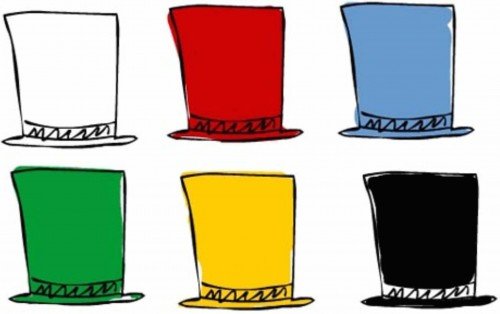
THE BIG IDEA: Conducting more effective meetings is a constant challenge. How do you manage conflict and internal tensions while enhancing ideation and collaboration? Use the Six Thinking Hats.
__________________
Do your meetings often become a political dance of excuse making? Do you consider most meetings you attend to be highly productive and results-oriented or are they mediocre and unnecessary?
There are many things you can do right away to make your meetings more productive. We offer 12 tips to improve meeting effectiveness here.
But why do meetings often fail?
The fundamental issue comes down to communication and our ability to see multiple perspectives. We tend to see the world through a single, fixed perspective.
If someone shares our perspective, we agree. When they don’t, we disagree. And when two people see different perspectives and can’t come to an agreement, communication stops. Progress stops too.
We are all capable of seeing multiple perspectives. It’s as easy as putting on one hat and taking off another. We aren’t the hat itself so we don’t identify with the hat. Each hat gives us a different perspective.
This is the insight behind creativity expert Edward de Bono’s Six Thinking Hat method.
The Six Thinking Hat Method
Edward de Bono developed a simple and effective way to facilitate more productive meetings by utilizing different perspectives.
Each hat represents a different perspective. Each team member wears each hat in turn. For example, “Okay, let’s put on our White Hats. Jim, you’re up first.”
Here’s a brief description of each hat:
White Hat: The neutral White Hat offers objective facts and figures and is used near the beginning of the meeting to establish relevant facts and information about the issue to be discussed.
Red Hat: The emotional and intuitive Red Hat is used to get people’s gut reactions to an idea or when you want the team to express their emotions freely.
Black Hat: The cautious Black Hat is used when you want to get the critical viewpoint of an idea or situation. The “devil’s advocate” hat helps decrease the chances of making a poor decision.
Yellow Hat: The sunny and positive Yellow Hat helps identify the value of ideas and plans. The Yellow Hat helps counterbalance the judgmental thinking of the Black Hat.
Green Hat: The creative Green Hat comes on when you want to generate fresh ideas and new directions. This is a very powerful hat that each player needs to wear.
Blue Hat: The organizing Blue Hat sets objectives, outlines the situation, and defines the problem in the beginning of the meeting and returns at the end to summarize and draw conclusions.
Improving Creative Output
Do you have someone in meetings that’s always shooting down new ideas?
That’s the Black Hat and it’s a vital perspective in business. But it’s only one perspective and people too often identify exclusively with it. When the Black Hat enters the meeting too soon, it squashes the free exchange of ideas.
To increase creativity in your brainstorming sessions:
- Start the meeting with a Blue Hat
- Highlight relevant facts with the White Hat
- Brainstorm new ideas with the Green Hat
- Build on ideas with the Yellow Hat
The Yellow Hat is perhaps the most powerful and under-utilized perspective. We are far more accustomed to shooting down ideas than seeking the positive attributes to them.
De Bono calls this value sensitivity. The more you develop value sensitivity in your team, the more innovative and open your meetings will become because your team will learn how to build on each other’s ideas instead of competing for their own ideas.
Creating an Open Exchange of Ideas
We all have feelings that influence our decisions. But we aren’t always aware of these feelings and, if we are aware, we often aren’t comfortable sharing them with others.
Our general lack of emotional intelligence is the single greatest barrier to effective communication, conflict resolution, and the free exchange of ideas.
Wearing the Red Hat helps quell this tension. The emotional Red Hat is a valid perspective that everyone has. If you encourage (actually, insist that) each team member wears the Red Hat, you’ll begin creating the space for better communication.
Remember, these six hats represent perspectives, not people or personalities. For this method to be used effectively, each person in a meeting can and must be able to wear each hat in turn.
(See de Bono’s Six Thinking Hats for further details.)
